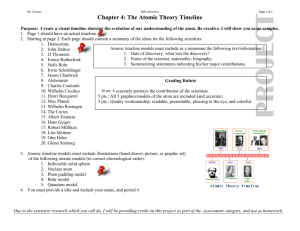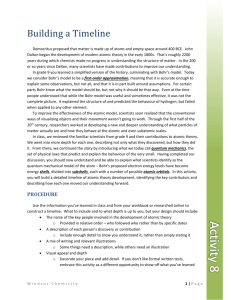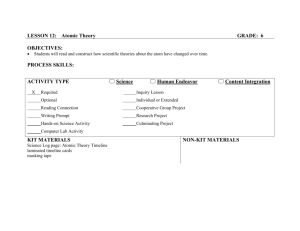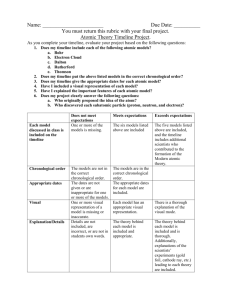Atomic Model Timeline Project: Science Worksheet
advertisement
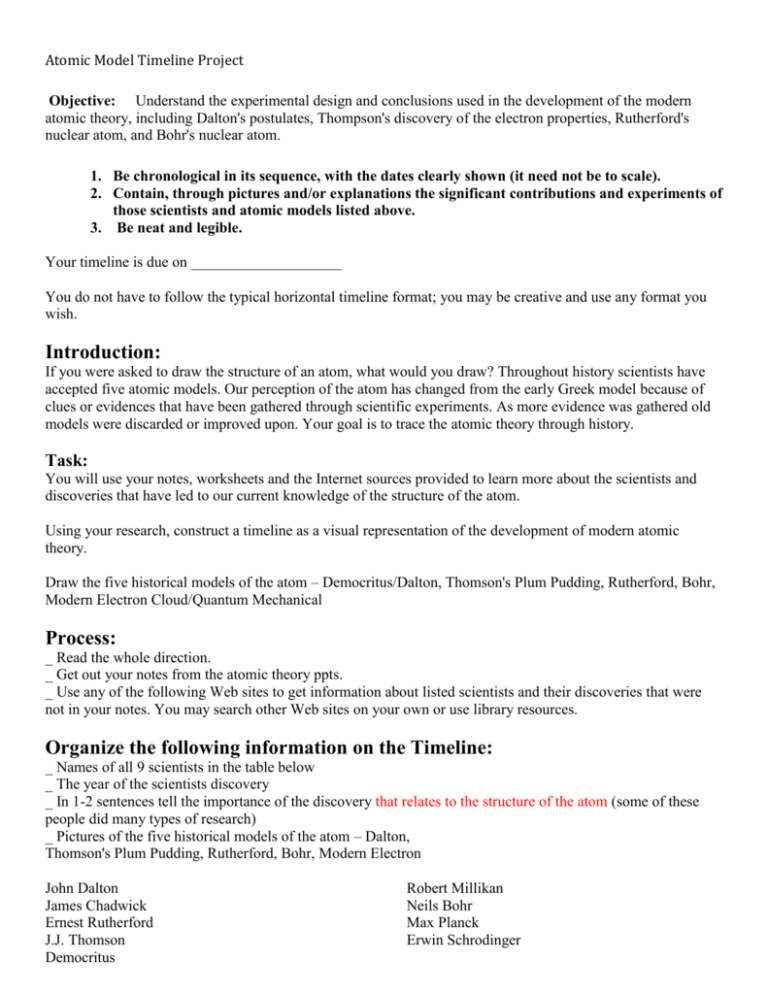
Atomic Model Timeline Project Objective: Understand the experimental design and conclusions used in the development of the modern atomic theory, including Dalton's postulates, Thompson's discovery of the electron properties, Rutherford's nuclear atom, and Bohr's nuclear atom. Atomic Model Timeline Project 1. Be chronological in its sequence, with the dates clearly shown (it need not be to scale). 2. Contain, through pictures and/or explanations the significant contributions and experiments of those scientists and atomic models listed above. 3. Be neat and legible. Your timeline is due on ____________________ You do not have to follow the typical horizontal timeline format; you may be creative and use any format you wish. Introduction: If you were asked to draw the structure of an atom, what would you draw? Throughout history scientists have accepted five atomic models. Our perception of the atom has changed from the early Greek model because of clues or evidences that have been gathered through scientific experiments. As more evidence was gathered old models were discarded or improved upon. Your goal is to trace the atomic theory through history. Task: You will use your notes, worksheets and the Internet sources provided to learn more about the scientists and discoveries that have led to our current knowledge of the structure of the atom. Using your research, construct a timeline as a visual representation of the development of modern atomic theory. Draw the five historical models of the atom – Democritus/Dalton, Thomson's Plum Pudding, Rutherford, Bohr, Modern Electron Cloud/Quantum Mechanical Process: _ Read the whole direction. _ Get out your notes from the atomic theory ppts. _ Use any of the following Web sites to get information about listed scientists and their discoveries that were not in your notes. You may search other Web sites on your own or use library resources. Organize the following information on the Timeline: _ Names of all 9 scientists in the table below _ The year of the scientists discovery _ In 1-2 sentences tell the importance of the discovery that relates to the structure of the atom (some of these people did many types of research) _ Pictures of the five historical models of the atom – Dalton, Thomson's Plum Pudding, Rutherford, Bohr, Modern Electron John Dalton James Chadwick Ernest Rutherford J.J. Thomson Democritus Robert Millikan Neils Bohr Max Planck Erwin Schrodinger A timeline is in chronological order – earliest time to latest time. Because you are going to keep your comments to 1-2 sentences, a graph or report will not be appropriate. Evaluation: Category 4 3 2 1 0 Dates/Scientist All scientists listed dates are correct and in order. All contributions listed and apply to the Atomic Theory All 5 models are drawn correctly and named Timeline and models are exceptionally attractive in terms of layout, neatness, and use of color. 6-8 scientists are list or 2 are out of order 4-6 scientists are listed or 3-5 are out of order 1-3 scientists are listed or 6-7 are out or order 0 scientist are listed or all are out of order 2-3 errors or contributions not listed or do not apply to the Atomic Theory 4 models are drawn correctly and named 4-6 errors or contributions not listed or do not apply to the Atomic Theory 3 models are drawn correctly and named 9 or more errors or contributions not listed or do not apply to the Atomic Theory 0 models are drawn correctly and named Timeline and models are attractive in terms of layout, neatness, and use of color Timeline and models are acceptable in terms of neatness, layout but no use of color 7-8 errors or contributions not listed or do not apply to the Atomic Theory 2 or 1 models are drawn correctly and named Timeline and models are messy with no use of color. Contribution to Atomic Theory Models of Atoms Attractiveness Timeline and models are not legible, messy and have no color.

